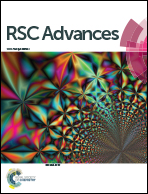Electrosorption of Pb(ii) in water using graphene oxide-bearing nickel foam as the electrodes
Abstract
The electrosorption of Pb(II) from water with graphene oxide-bearing nickel foam (GO/NF) as the electrodes was studied in this work in order to develop a more effective method for Pb(II) removal. The GO/NF was synthesized via vacuum impregnation method. The characterization of the materials was performed through atomic force microscopy, adsorption capacity, zeta potential and X-ray photoelectron spectroscopy measurements. The experimental results have shown that a very large adsorption capacity (3690 mg g−1) and high adsorption rate were achieved for electrosorption. The adsorption fitted the Langmuir isotherm and was in good agreement with a pseudo-second-order kinetics model. The mechanism might be attributed to electrosorption and chemisorption, in which the oxygen containing functional groups of graphene oxide offered a large amount of lone pair electrons for complexation with Pb(II) ions and thus enhanced the hydrophilicity of GO/NF electrodes. It has been demonstrated that electrosorption with GO/NF as the electrode could be a very promising process for removing Pb(II) from water.



 Please wait while we load your content...
Please wait while we load your content...